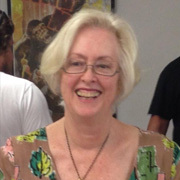
Sandy Houston
Sandy Houston's CV ranges from London to California to Wellington, and includes many projects that mark key turning points in the evolution of special effects — Young Sherlock Holmes, Jurassic Park, Forrest Gump, Avatar. Having started in traditional hand-drawn animation, she was at company ILM as computers transformed the art of screen illusion, then returned to Wellington as Weta Digital was making its own contributions to the world of special effects.
Film runs in Houston's family. Her father Ian worked as a sound recordist in London, while her Scottish-born mother Kathleen went to art school then worked on the first of many animated films. Sandy was born after the couple married in Bombay during WWll, where both were making films for the British Army. Finding little work after the war, the Houstons headed downunder to Wellington, and Ian began at the National Film Unit (Sandy's brother Kent has also done many years in special effects).
Unsure what path to take, Sandy headed to England in 1966 on her OE, where animator Bob Godfrey — a friend of her mother — took her on for BAFTA-nominated short Henry 9 'til 5. Houston worked at other animation companies in London, then did four years in Greece. Back in the UK, she worked on animated images for Pink Floyd, and joined the team on 1979 animated hit Watership Down. Watership director Martin Rosen then set up an animation studio in San Francisco. Houston spent two years there, working on Rosen's acclaimed but little seen follow-up The Plague Dogs.
Houston was doing TV animation in California, when a friend recommended her for a rotoscoping job at Industrial Light and Magic. The effects company was gaining staff and work, on the back of the Star Wars films. Having seen how the rotoscoping worked on the Fred and Ginger dance sequence in animated classic Yellow Submarine, Houston said she could do it. Rotoscoping is used to combine two different elements — eg an actor's hands, holding a glowing computer-generated ball — into one shot. By drawing a precise line around the edge of the actor's fingers, they can be combined with the CG-created image. Computers transformed the task, providing tools that made the work easier and faster; they also unleashed a wealth of visual possibilities that kept rotoscopers in demand.
Rotoscoping wasn't the only thing affected; on productions like Who Framed Roger Rabbit, Jurassic Park and Forrest Gump, new technologies were developed on the run, which opened up new ways to create and combine images. "The collaborative effort was pretty exciting," says Houston. "A lot of different skills were being used. In the animation section the the cameras were often going for 24 hours straight."
Houston remembers Steven Spielberg's Hook (1991) as another sign of how visual effects were changing. The Peter Pan tale was shot almost entirely in a studio; as she looked at some of the footage, she noticed that studio lights and a messy seam on the green screen were visible. In the past, such elements would have been challenging to remove. "But we were going to be able to change what was shot by painting it out frame by frame —with animated paint."
Houston's time in the States included seven years at Disney's visual effects arm The Secret Lab (where she found herself using digital paint to remove spots from the puppies in 102 Dalmations), and 10 months at Dreamworks. In 1996 she returned to Wellington to help on the final rush to complete The Frighteners (1996), the film on which Peter Jackson began making extensive use of digital effects.
After Disney closed down, Houston took up an offer to return to Weta Digital in 2003. On hand in time to work on triumphant Lord of the Rings finale The Return of the King, Houston went on to supervise Weta's rotoscoping team on over two dozen projects, over the next dozen years (she retired in 2014). Among them were visual effects Oscar-winners Avatar and King Kong ( "a very difficult" project for the rotoscoping team, thanks to all the gorilla fur on screen) — plus District 9 and Rise of the Planet of the Apes. The Adventures of Tintin remains a personal favourite; her Siamese cat Koko was brought into the studio, to provide source imagery for the film's feline character.
Houston reckons that one of the key tasks of being a rotoscope supervisor is being able to pick the people whose individual talents will best match the shot they are working on. "It's a fabulous job," she says of her time in the screen industry. "You get a real feeling of wanting to do your best — and have fun at the same time."
Sources include
Sandy Houston
'Sandy Houston: Dinosaurs, dalmatians and a cat named Koko' (Video Interview) NZ On Screen website. Director Jess Charlton. Loaded 30 June 2017. Accessed 30 June 2017
Richard Rickitt, Special Effects: The History and Technique (London: Aurum Press, 2006)